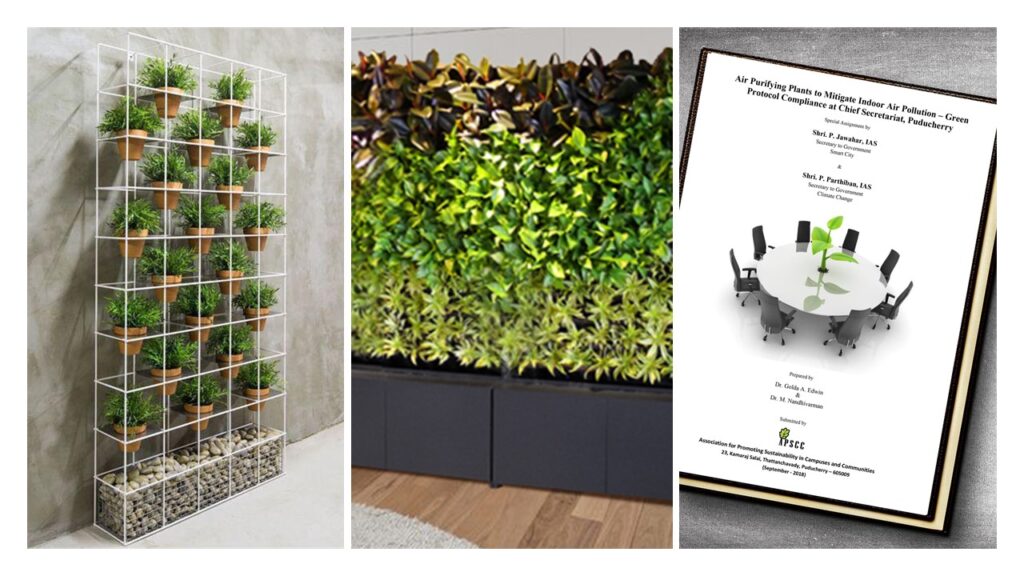
Indoor air pollution is a silent yet pervasive threat that significantly affects the health, well-being, and productivity of individuals in workplaces. Hazardous substances like volatile organic compounds (VOCs), particulate matter, and carbon monoxide are often present in enclosed spaces, leading to adverse health effects even at low concentrations. Recognizing the urgency of this issue, the Association for Promoting Sustainability in Campuses and Communities (APSCC), in collaboration with the Chief Secretariat, Puducherry, launched a green initiative under the leadership of Shri P. Jawahar, IAS (Secretary to Government – Smart City) and Shri P. Parthiban, IAS (Secretary to Government – Climate Change).
This initiative aligns with the Comprehensive Green Protocol and aims to mitigate indoor air pollution by leveraging the natural air-purifying properties of plants.
Understanding the Problem: Sources of Indoor Air Pollution
As identified by the United States Environmental Protection Agency (USEPA), common sources of indoor air pollution include:
1.Asbestos
2.Carbon Monoxide (CO)
3.Formaldehyde from pressed wood products
4.Nitrogen Dioxide (NO2)
5.Pesticides and VOCs
6.Indoor particulate matter
7.Secondhand smoke
8.Appliances like stoves, heaters, and chimneys
To combat these pollutants, this program focuses on air-purifying plants that address harmful substances such as trichloroethylene, benzene, xylene, and ammonia.
Air Purifying Plants: Nature’s Solution to Pollution
NASA’s Clean Air Study highlights several plants with proven air-purifying properties. These plants not only filter toxins but also improve air quality, providing a healthier and more productive workspace.
Recommended Air-Purifying Plants
1. Spider Plant (Chlorophytum comosum)
- Pollutants removed: Formaldehyde, xylene, toluene.
- Care: Low maintenance. Prefers indirect sunlight and moderate watering.
- Why it’s effective: Spider plants are hardy and fast-growing. They are also non-toxic to pets.
2. Snake Plant (Sansevieria trifasciata)
- Pollutants removed: Formaldehyde, benzene, xylene, toluene.
- Care: Extremely low-maintenance. Thrives in low light and needs minimal watering.
- Why it’s effective: It can perform photosynthesis at night, releasing oxygen and absorbing carbon dioxide, making it a great addition to the bedroom.
3. Peace Lily (Spathiphyllum)
- Pollutants removed: Formaldehyde, benzene, trichloroethylene, ammonia.
- Care: Prefers indirect light and consistently moist soil. It also benefits from regular misting.
- Why it’s effective: Peace lilies not only purify the air but also add humidity to the environment, which can be helpful in dry indoor spaces.
4. English Ivy (Hedera helix)
- Pollutants removed: Benzene, formaldehyde, xylene, toluene.
- Care: Prefers bright, indirect light and regular watering. Can grow as a hanging plant or a climbing vine.
- Why it’s effective: Known for its ability to remove volatile organic compounds (VOCs) and its flexibility in different environments.
5. Aloe Vera (Aloe barbadensis miller)
- Pollutants removed: Formaldehyde, benzene.
- Care: Needs bright, indirect sunlight and occasional watering (allow the soil to dry out between waterings).
- Why it’s effective: Aloe vera is not only great for improving air quality but also has healing properties, especially for burns and skin irritations.
6. Bamboo Palm (Chamaedorea seifrizii)
- Pollutants removed: Formaldehyde, benzene, trichloroethylene.
- Care: Prefers indirect light and regular watering. Can tolerate lower light conditions.
- Why it’s effective: This plant is an excellent air purifier and also adds a tropical feel to any room.
7. Gerbera Daisy (Gerbera jamesonii)
- Pollutants removed: Benzene, trichloroethylene, formaldehyde.
- Care: Prefers bright light and slightly moist soil. Keep in a sunny spot for the best blooms.
- Why it’s effective: Known for brightening up indoor spaces with its colorful flowers while absorbing harmful chemicals.
8. Areca Palm (Dypsis lutescens)
- Pollutants removed: Formaldehyde, xylene, toluene, and other VOCs.
- Care: Prefers bright, indirect light and regular watering, but should be allowed to dry slightly between waterings.
- Why it’s effective: Excellent for purifying the air and also adds humidity to dry environments.
9. Rubber Plant (Ficus elastica)
- Pollutants removed: Formaldehyde.
- Care: Prefers bright, indirect light and moderate watering. It can tolerate some neglect but thrives with regular care.
- Why it’s effective: Known for its large, glossy leaves that trap airborne toxins.
10. Golden Pothos (Epipremnum aureum)
- Pollutants removed: Formaldehyde, benzene, xylene, toluene.
- Care: Extremely low maintenance. Tolerates low light and irregular watering.
- Why it’s effective: Pothos is not only a great air purifier, but it’s also easy to grow and propagate. It can be placed in hard-to-reach spots.
11. Philodendron
- Pollutants removed: Formaldehyde.
- Care: Prefers indirect light and moist, well-drained soil.
- Why it’s effective: Philodendrons are particularly good at filtering out formaldehyde and are easy to care for.
12. Boston Fern (Nephrolepis exaltata)
- Pollutants removed: Formaldehyde, xylene, toluene.
- Care: Prefers indirect light and humid conditions, so regular misting can help.
- Why it’s effective: This fern is known for its ability to act as a natural humidifier, improving both air quality and moisture levels.
Implementation: Green Protocol Compliance
The program at the Chief Secretariat, Puducherry, aims to integrate these air-purifying plants into office spaces, fostering:
1.Cleaner Indoor Air: Reducing harmful pollutants.
2.Improved Productivity: Healthier employees lead to better work performance.
3.Green Aesthetics: Enhancing workspace ambiance and reducing stress levels.
4.Sustainability Awareness: Promoting eco-friendly practices among employees and visitors.
The introduction of air-purifying plants at the Chief Secretariat represents a significant step toward achieving Green Protocol compliance in Puducherry. Beyond improving indoor air quality, this initiative serves as a model for other government and private institutions to adopt similar sustainable practices.
Additionally, promoting these plants through government and private nurseries can increase vegetative cover, provide educational opportunities, and create avenues for revenue generation through green entrepreneurship.
